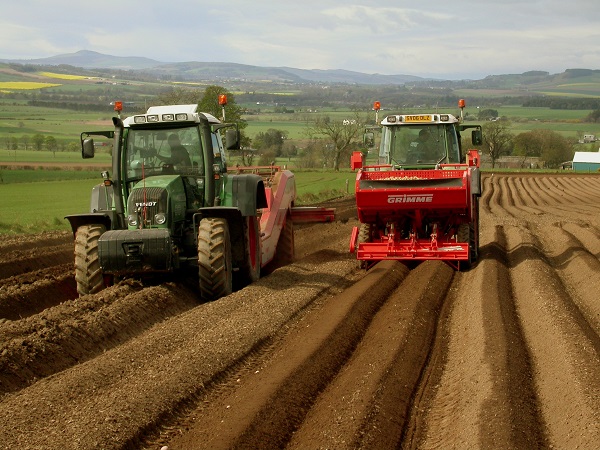At first sight the intensive processes involved in growing a crop of potatoes don’t seem particularly environmentally sensitive. CPM looks at how the sector is rising to the challenge of climate change.
Gathering carbon data is currently mostly driven by the supply chain.
By Lucy de la Pasture
Potato growers would be first to raise their hands and admit that growing the crop is dependent on deep cultivations which burns a lot of fuel and energy-sapping storage regimes. Both are costly on the balance sheet and in terms of carbon emissions.

But when it comes to understanding their carbon footprints, many potato growers are already ahead of the curve and have got a handle on their GHG emissions. It’s not so much that potato growers were born with a more highly attuned environmental conscience, more that they operate in much closer proximity to the consumer in the supply chain, says Sarah Wynn, who heads up ADAS’ sustainable food and farming division.
“Gathering carbon data on the farm is currently mostly driven by the supply chain asking the grower for that information. But we’ve found that once growers start to engage in the process then they soon see that just small actions can make big differences to their carbon footprint,” she says.
Sarah was involved with the PepsiCo ’50 in 5’ initiative, which achieved the lofty aim to reduce growers’ GHG emissions and water usage by 50% in just five years. During the initiative, which began in 2010, ADAS worked closely with both the growers and the team at PepsiCo to understand where the emissions hotspots were in potato production, plan actions to reduce the emissions and then monitor progress over time.
This work was facilitated through the use of the Cool Farm Tool, a carbon calculator to measure GHG emissions. Using this data, carbon management plans were developed by ADAS to identify actions to reduce emissions in future years.
“Carrying out a carbon footprinting exercise is something most arable growers can easily do for themselves using one of the many tools which are freely available,” says Sarah, but she stresses the result will only be as good as the data that’s put into the calculator.
In the 50 for 5 project growers were initially sceptical and wary, she explains. “The level of engagement and understanding of the reason for the project, as well as the benefits to the business, increased throughout the process. The end result was that after five crop years the Walkers Crisp growers had managed to reduce their emissions by 50%, doing their part for increasing the sustainability of our food supply chain.”
Looking back at the project, Sarah highlights key areas where the savings were made. These included improved storage practice, implementation of renewable energy sources on farm, improvements in yield driven by switching to new varieties, optimisation of nitrogen applications and use of new technologies such as drip irrigation and GPS systems in tractors to reduce fuel usage.
“Growers have been looking beyond carbon management and are taking further actions to reduce water use, encourage biodiversity and protect soils. The actions taken by growers as part of ‘50 in 5’ have meant additional financial benefits through reduced inputs such as electricity, water and artificial fertilisers,” she says.
The opportunity to save costs (and hence carbon cost) by reduced depth of cultivations and less secondary tillage has been highlighted in work funded by AHDB (Project R459 2012-2015) and carried out by NIAB CUF senior researcher, Dr Mark Stalham. The results demonstrated that soil shouldn’t be cultivated deeper than is necessary to produce destoned beds of 27-28 cm (clay soils 23-25cm) in depth prior to planting. Working the soil any deeper than this reduced yield and increased fuel consumption, labour, repair and depreciation costs.
The advantages from reducing cultivation depth are another clear indication of the link between reducing GHG emissions and increasing productivity in a more efficient system, says Sarah.
One of the simple measures that growers can take to reduce their carbon footprint is to buy abated fertiliser rather than cheaper, non-abated alternatives, says Sarah. It’s a good starting point, agrees Yara’s head of agronomy, Mark Tucker, but the nutrient-use efficiency is determined by what happens when it’s applied.
“Conditions during application are important. If the soil is wet, cold and compacted then N2O emissions will increase because of anaerobic conditions within the soil profile. So soil needs to be in good health especially in terms of its structure and porosity,” he says.
Mark says it’s also crucial to use as little fertiliser as is possible to match crop demand with nutrient supply to get the best nutrient-use efficiency (NUE). For nitrogen fertiliser, NUE is typically only 30% so it’s an area where there’s scope for improvement and the United Nations has targeted an increase to 60% under their sustainable development goal.
“Focusing on improving plant health and rooting systems will help improve nutrient-use efficiency, as well as precision farming which places the right amount of nutrients where they’re most needed,” he says.
David Marks, managing director of Levity Crop Science, believes there’s scope to take a step further when it comes to looking at fertiliser GHG emissions.
“These include the carbon cost before they hit farm (manufacture, distribution, use and packaging) and loss before they get into a crop (nitrogen use efficiency), which are the two areas most discussed. But just as important are how much growth crop and marketable yield is achieved per unit applied.
“The first two areas are well characterised, with much of the legislative focus being on replacing with natural sources (less energy in production) and reducing losses through altered agronomy and chemical treatments, such as urease inhibitors,” he comments.
So it’s not just about how the plant takes up the nutrient, it’s also about how the plant then uses it for growth. David’s main research focus is on driving more growth per unit by understanding how the three forms of nitrogen (amine, ammonium and nitrate) affect growth and biomass partitioning.
“So the energy per unit growth and where the plant places growth, that is reproductive versus vegetative, is important. To truly have a measure of the efficiency of nutrient use then it’s important to account for the usable parts of the crop,” he says.
In potatoes, for example, nitrogen may be taken up by plants, but the form it’s supplied in may influence excess haulm production rather than tuber growth. It’s an area that’s poorly understood and isn’t taken into account by legislation, he explains.
“Plants are essentially factories for converting carbon into biomass. When plants metabolise nitrates to form proteins, they use 12 times more carbon to process a unit of nitrate into a plant protein than if the nitrogen is taken up in the amine form. So it’s more energy efficient for the plant, which makes more available for growth,” he says.
“The practical implication of this is that repetitive small bursts of foliar amine-N to the potato crop can influence partitioning, with more growth going into the tubers, increasing the harvestable fraction. The implication to net zero carbon is that if you can harvest more N than you’re applying through having a more efficient plant, then the crop itself becomes a carbon sink.”
The third main area on potato farms where carbon losses can be tackled is storage. Concentrating on efficiency of stores and switching to renewable energy sources making a big different to their carbon footprints, says Sarah.
Summing up, Sarah highlights that all the small changes a farming business can make towards lowering GHG emissions will save the grower money in the end as they move towards a more productive, efficient farming system.
“After all, reducing GHG emissions from agriculture goes hand in hand with improving the efficiency of production making it a win-win for farmers. When you break it down it’s about using the right fertiliser, at the right rate and at the right time; efficient cultivations; and optimising storage energy use using renewable energy.”
The success of PepsiCo’s 50 in 5 initiative caught the eye of the politicians, and potato growers have shown it’s possible to make huge improvements without the need for legislative measures. Andrea Leadsom, who was then Environment Secretary said, “The 50 in 5 is an excellent example of British talent creating innovative, pioneering technology that is now transforming agriculture both in the UK and beyond.”
Whichever way the political wind blows, Sarah believes that growers who embrace carbon footprinting and accounting on their farms will have an easier market for their produce in the future.




